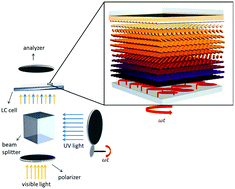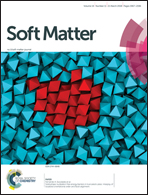Surface induced twist in nematic and chiral nematic liquid crystals: stick-slip-like and constrained motion†
Abstract
Surface driven pattern formation is an intriguing phenomenon in the liquid crystal field. Owing to its ability to transmit torque, one can generate different patterns by propagating distortions on the optical wavelength scale in the sample from the surface. Here, we theoretically investigate (from the elasticity point of view) twist deformations induced by a rotating easy axis at one surface, by considering the anchoring energy and surface viscosity of nematic and chiral nematic samples. The model is solved analytically in the limit of strong anchoring and numerically for a low anchoring strength situation. Such rotation could be induced, in principle, by light-controlling the orientation of an azobenzene monolayer coated at one of the glass substrates or by an in-plane rotating field. We discuss the role of the surface parameters and the different distortions, and calculate light transmission using the Jones method. Three different regimes are identified: free twist, stick-slip twist, and constrained twist. The results obtained here may be relevant for liquid crystal active waveplates and for determining surface viscosity and the azimuthal anchoring energy.



 Please wait while we load your content...
Please wait while we load your content...